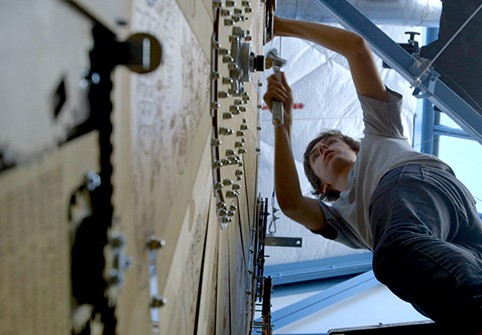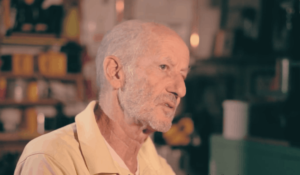Most Likely to Succeed: A Film About What School Could Be

When his bright fun-loving fourth grader started failing in school and coming home frustrated, Greg knew something was wrong. The teacher called it an opportunity to learn perseverance (at least she had been reading about mindset). To the dejected picture of his daughter, Greg said, “She called BS on school” and to the worksheets and tests designed to prepare her for some job.
The opening scene of Most Likely to Succeed was particularly poignant for me having seen that same look after parent-teacher conferences with my own fourth grader at a very traditional school twenty years ago.
Produced by Greg Whiteley, the documentary film Most Likely to Succeed debuted at Sundance and will be featured at SXSWedu on Tuesday on March 10.
The executive producer, Ted Dintersmith spent decades as a successful venture investor building and adapting mental models of the economic world. His career has been about innovation and entrepreneurs and, as a result, he claims to have some appreciation for what the new, “Economy will be like and what types of capabilities will be required.” Watch a clip of Ted from the movie:
Ted brought the film to a Learn Capital summit in Utah this week where a small group of thought leaders and edupreneurs had the opportunity to get the backstory from Dintersmith.
“What I find shocking is that schools aren’t preparing our kids for life in the 21st Century. Surrounded by innovation, our education system is stuck in the 19th Century,” said Dintersmith. “The skills and capabilities our kids need going forward are either ignored or outright trampled.”
Ted is now on a mission to change our education system “so that it promotes, instead of vitiates, innovative kids.”
In a brief visual history of the last 124 years, the film outlines how the Committee of 10, based on the Prussian model, adopted courses, subjects and age cohorts. For decades this factory model prepared an adequate number of workers for the economy.
With stubbornly high levels of young adult unemployment and underemployment, the film explores the broken bargain that diplomas equal employability. Greg outlines the core premise, “Enduring school to get a job may not be true anymore.”
Startling shift. In 1997 chess champ Gary Kasparov was beaten by a computer. Fourteen years later, IBM’s Watson beat Ken Jennings in Jeopardy. By 2014, companies like Narrative Science are able to produce a coherent computer generated corporate earnings report. This “startling shift” according to MIT’s Andrew McAfee signals the beginning of AI doing to white collar jobs what robotics did to blue collar jobs. The author of Race Against the Machine is featured in the film along with Ken Robinson, Tony Wagner, and Linda Darling Hammond.
The star of the film is High Tech High in San Diego (featured here), a place where teachers have the freedom to shape projects that culminate in public exhibitions.
“Most of life is a project and exhibition,” said High Tech High founder Larry Rosenstock (see 10 more school design quotes from Rosenstock). Trained as a lawyer, Rosenstock taught high school carpentry. Larry’s maker ethic is baked into the frequent exhibitions of authentic work at High Tech High.
Quietly railing against conventional wisdom of longer day, longer year, and test prep, Most Likely to Succeed argues that it’s “time for another transformation.”
The film honors the parental dilemma of wanting to see the enthusiasm associated with engaging work but hoping for good grades and test scores sufficient to gain access to target colleges. It doesn’t offer a prescription but it criticizes the old model of rows of compliant students regurgitated facts and celebrates active engagement, challenging work, and authentic demonstrations of learning.
The story of students at High Tech High preparing for conducting their term-end Presentation of Learning is an inspiring picture of what many of us hope for millions of American students.
Theory of change. Beyond advocacy, Ted supports Future Project, an NYC nonprofit that puts Dream Directors in schools that helps kids identify dreams they want to explore. He also supports Providence-based NBA Math Hoops which leverages youth interest in basketball to help them develop stronger math skills, and appreciate and love the power of math.
Dintersmith is optimistic about the film’s ability to create conversation with parents and teachers. He’s already got another film in progress.
Like Ted, I’ve long been inspired by the High Tech High pedagogy of projects and presentation. As a conversation starter Most Likely is among the best edu-documentaries ever produced. It is a provocation rather than a prescription.
Go to LikelyToSucceed.org and sign up for updates and screening notifications. When you see it, I hope, like for any policy provocation, you ask, “How will this benefit kids from low-income families?” There’s not a simple answer to that question.






Justin Aglio
Thank you for sharing!
Cap Lee
Exactly right. The system of education was never designed to serve all kids and was never designed for kids to really learn what is valuable https://rowman.com/ISBN/9781475817713
Lisa
LOVE the concept, love the ideas. I would LOVE to work in a school like this. It's lonely trying to implement discovery in learning in solitary. I got a real kick out of the Socratic Seminar video and have had similar results. Good stuff! Sharing!
Brenda
My daughter is 13, 7th grade in the public school system. She's smart as a whip and full of ideas and concepts with no outlet in her school environment. Financially, I cannot afford private school. As a single working mom, home schooling is not an option. Her grades declined over the past two years and it is frustrating for me to feel I have to reinforce in her that she needs to conform and excel if she wants a shot at the limited magnet schools and tech academies that are now on a lottery system for availability. The future looks like public high school... I love following the Teachers Throwing Out Grades group which is how I found this! I wish there were a quicker way to overturn our current education system and allowing one that encourages and motivates our children to realize that they have no boundaries to limit their potential. Thanks for letting me rant!
Richard Taylor
Tom
Looks like a great film and I will see if we can organsie a showing in London and beyond, perhaps at an event that mirrors (in a small way) your recent Learn Capital summit. This would be a more edu & educator focused version of Edtech Europe which Michael Staton of Learn Capital spoke at last year.
chris sturgis
Tom, I agree that the film is provocative. I'm worried that it may be provocative in ways that the filmmakers might not expect. As much as I loved most of the film, I thought the film gives a white-washing of America and American history that will raise questions and suspicions about the message of the film. I think they could make a few small changes and make it a film that will resonate will all the diversity of America. Here is my critique and suggestions: http://www.competencyworks.org/reflections/most-likely-to-succeed-is-almost-a-great-film/
Replies
Tom Vander Ark
thanks for this thoughtful response Chris
Principal Nieukirk
Wow! An inspiring school and what education should look like. Has many components I find in our IB PYP school
Lisa
High School teachers want to prepare students for colleges/universities, middle school teachers want to prepare students for high school, lower school/elementary school teachers want to prepare students for middle school. Why don't we teach at the moment? Why do we have to always teach to "prepared" when teachers don't even know what the future requires? Stop this vicious cycle.
Tim
The film was well done however the concept depicted is BS. I ask you this, would you allow a doctor to perform life-saving open heart surgery on you if they had not been educated on and memorized to the point of absolute knowledge the cardiac vascular system? How about a chemical engineer designing a reactor that would be handling high volatile chemicals that could cause loss of life if the plant was not design correctly utilizing thermodynamics, kinetics etc.
If one is OK with these conditions then by all means accept lower standard education.
Replies
Tom Vander Ark
Hi Tim
Schools like HTH may cover less material than traditional schools but they trade superficial knowledge for deep understanding. Scan HTH projects and you’ll appreciate that HTH experiences are memorable for a lifetime and equip students with the skills to take on big challenges. Addressing similar concerns from David Brooks, I wrote this response:
http://www.gettingsmart.com/gettingsmart-staging/2015/10/schools-for-wisdom-personalized-project-based-learning/
Jason
Tom - thanks for replying to Tim and indirectly Lisa above. Your linked article above was helpful in understanding further. I have a few comments/questions:
1. Ability to execute is dependent on the adult in the room. You may say that independent learning as you describe takes less oversight on the part of the teacher and hence the fact that teachers have not been trained to 'teach' in this way is of little consequence. That the program if followed correctly is easy to learn from a teacher's perspective. How true is this and how did you measure it? I have seen countless changes implemented at my kids school, an American school overseas that lives on their mission for treating the school as a petri dish for educational experimentation, and yet when one asks how they measure their success or failure of their innovation it turns into a staring context. I take the point in your linked article that it is good to keep challenging conventional wisdom and I could not agree more. However, if you are not measuring or cannot measure your effectiveness then you are seeing up for failure because how do you know when to pivot? Is gut feel the only input?
2. Are you a tree in the woods? Taking from Lisa comments, high school is attempting to prepare for college and beyond. Is your suggestion being heard and appreciated by colleges (which ones?) and do you have any feedback information from former students as to their readiness for college after living through your program? Because lets face it you and I could dream up a new world order for teaching but if nobody is there supporting it then did it really happen? Are you prepared to sacrifice the collegiate success of students today for the greater good? Two senior representatives from Brown and Penn came to my referenced school last year and met with about 200 hundred parents. They were asked if they were aware of the many innovations at this high school and if so what where thoughts, did they support etc. The answer was direct and clear, yes fully aware, not changing their view of the school but did offer one clear directive and that was, and I quote "Please please please give us stronger writers". What is your response to that?
3. How scalable is your idea. How do you have internships and mentors for a high school with 300 students per grade? How many projects would have to be in play at anyone time and what depth of oversight expertise is required to ensure this time is not gamed by your resourceful students to use as 'blowing off' time?
Thats all for now. Thank you for considering a rely.
Replies
Tom Vander Ark
Hi Jason, I don't have a school or program, I visit schools and write about what I appreciate.
See my new case study on Singapore American School, a school moving away for reliance on ACT/SAT and AP tests to broader measures of college/career readiness: http://www.gettingsmart.com/gettingsmart-staging/publication/creating-future-learning-singapore-american-school/
Tom Vander Ark
On scalability (#2), it's clear that good small schools are scalable (about 5000 have been opened in last 15 years) but they're slow and expensive. To your question, can we scale these strategies (i.e., strong relationships, meaningful work) to big struggling existing schools--well, that's a lot harder (I spent $1b trying). I've seen it work but it takes heroic leadership.
Tom Vander Ark
On HigherEd acceptance (#2), we've seen a lot of movement in the last few years in considering broader measures.
The most promising regional shift is in New England where the Great Schools Partnership is working with high schools, 6 state legislatures, and 60 state universities that accept a proficiency-based diploma, read more: http://www.gettingsmart.com/gettingsmart-staging/2013/12/consortium-points-way-proficiency-based-learning/
Jason
And if I may add, how do you reconcile this article and its linked reference to an article you wrote a couple months ago advocating for teacher-run schools? Is it not true that all these 'innovations' are the brain child of administrators and layman and not actually the educators in the classroom? Just curious about what appears to be a contradiction. Happy to stand corrected.
Replies
Tom Vander Ark
Hi Jason, HTH was founded by Larry Rosenstock, a gifted educator with 20 years of experience teaching, running great schools and advocating for better schools before founding HTH. All 66 high schools worth visiting were designed by committed educators: http://www.gettingsmart.com/gettingsmart-staging/2015/11/66-secondary-schools-worth-visiting/
Jason
Tom - a sincere level of thanks for responding so promptly and engaging. I openly apologize for responding back with additional commentary but I do so simply as means of addressing my genuine curiosity and interest in the topic. I have one rising college sophomore and a rising HS senior and have been engaged in this topic with professionals around the US and abroad for about 5 years. In any event some additional bits of thought:
1) notwithstanding merits and sound rationale there is still a sizable execution risk in that if the educators are not buying into the structure or simply lack the tools to do so then it will likely fail. And by fail I mean the program will leave behind the middle 70%. Clearly the approach benefits the top 15% who are driven on their own and do not need any real guidance in terms of achievement levels and the bottom 15% probably do not care or will focus on their individual craft. What trouble me is I have seen the middle being displaced in terms of motivation to go beyond their default 'laziness' as a common teenager. If the execution by the teacher is not very tightly monitoring and making connections with students then these students will be left to there own devices which means you are leaving proverbial cards on the table. I have found that great educators thrive under any operating structure because they know how to engage each of his or her students and get more out of them than they ever imagined possible and they do this year after year with new sets of students. But lets be honest and agree that these professionals are in the minority. Not a slam but not all educators are rock stars and that is fine. But what it means is a program needs to be designed to ensure the average educator can leverage it for the benefit of students. I read your SAS profile and I know the school well. Goals do not mean results if the goals cannot be executed as designed or are not measured and managed on a regular basis or lack buy-in from the educators. Meeting a few people may not tell the tale of truth rather it may simply tell a tale.
2) I read your referenced article and totally agree with standards based approach. There are so many obvious benefits. But again it goes to execution.
3) I recently spoke with a leader in the California public school system responsible for math from grades 1-5. We debated common core amongst many other things. After about two hours of constructive back and forth her challenging some of my crazy comments and me her materially more foundational thoughts, I asked her a simple question: it sounds like what should be the case is that public schools should throw out the model of students staying with one educator all day and instead go to a math teacher who only teaches math and knows how to teach effectively, knows how to spot a kid struggling with concepts and work directly with that child in a way that does not leave them behind and then I asked if she agreed. She was 100% in agreement but said no way can public schools afford to do this and labeled it the gold standard approach for sure. When I mentioned my kids school that is private with substantial financial resources still does not do this she was shocked and did say there is more focus on other forms of innovation than necessarily getting the right educators in front of the students. I am curious of your reaction to this discourse.
Thanks again Tom for being so engaging and enduring my long windedness.
Jason
One final thought:
What I am seeing at HS seeking to apply their skills to innovate how schools execute is that it is creating a tutor culture. The families that can afford it have trouble with applying blind faith in a school implementing material innovation and so send their kids to tutors after school. As an example, when my kids were in elementary school Everyday Math was adopted as the new world order. Parents tried to endure but complaints came from every where. Students were not learning, teaches did not know how to teach in the mandatory way and parents were furious that their kids were guinea pigs. So parents sent their kids to math tutors in droves. The school claimed success because a standardized test said grades were up. We parents asked the school to parse the results between tutored kids and non-tutored kids. The resisted at first but then did so privately. Everyday math was scrapped a couple years later. Too bad for the non-tutored kids. Or more directly, too bad for the poor kids. Look at the stats of tutor business growth. It is off the charts. Cause and effect? Again I ask how are these programs measured in terms of assessing effectiveness relative to goals? I ask this question to so many education innovators and nobody can ever give me an answer beyond trust us we are professionals or more often silence. I wonder if this is the right answer? I wonder if my investors will accept me answering their demand for analysis of my decisions with an effective "hey back off I know what I am doing". Makes me curious.
Replies
Tom Vander Ark
No question it's mostly about execution. That's one reason we're excited about the combo of personalized and project-based learning--customized skill building supports and high engagement challenging assignments. Read about NewTechNetwork.org and other leading networks combining playlists and projects: http://www.gettingsmart.com/gettingsmart-staging/2016/05/personalized-project-based-learning/